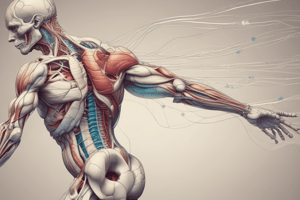Podcast
Questions and Answers
What surrounds the entire muscle?
What surrounds the entire muscle?
- Perimysium
- Epimysium (correct)
- Endomysium
- Fascia
Which of the following is a characteristic of muscle fibers?
Which of the following is a characteristic of muscle fibers?
- They are the largest unit of skeletal muscle organization
- They are a type of connective tissue
- They are about 3 cm long and 0.05 mm wide (correct)
- They are surrounded by perimysium
What is the function of the epimysium layer?
What is the function of the epimysium layer?
- To surround individual muscle fibers
- To bind all muscle fibers together (correct)
- To surround the entire skeletal muscle system
- To surround fascicles
What is the correct sequence of skeletal muscle organization?
What is the correct sequence of skeletal muscle organization?
Which of the following is NOT a characteristic of a muscle fiber?
Which of the following is NOT a characteristic of a muscle fiber?
What is the primary function of skeletal muscle?
What is the primary function of skeletal muscle?
Which type of muscle is known for being involuntary and non-striated?
Which type of muscle is known for being involuntary and non-striated?
What percentage of a person's body weight is made up of skeletal muscles?
What percentage of a person's body weight is made up of skeletal muscles?
What is the term for the study of the structure, function, and diseases of muscle?
What is the term for the study of the structure, function, and diseases of muscle?
What is a characteristic feature of skeletal muscle when examined under a microscope?
What is a characteristic feature of skeletal muscle when examined under a microscope?
Flashcards are hidden until you start studying
Study Notes
Muscular System
- Muscle tissue is specialized for contraction and makes up about 40% of a person's body weight.
- There are over 650 skeletal muscles in the human body.
Types of Muscle
- There are three types of muscular tissue: skeletal muscle, cardiac muscle, and smooth muscle.
- Skeletal muscle:
- Found attached to bones of the skeleton
- Voluntary, striated
- Attached to bone and causes movement of the body
- Known as voluntary muscle because it can be contracted at will
- Appears markedly striated when examined with a microscope
- Cardiac muscle:
- Found in the heart
- Involuntary, striated, branching
- Smooth muscle:
- Found in organs
- Involuntary, non-striated
Functions of Muscle
- Produce body movements
- Maintain posture/body position
- Heat production
Microscopic Anatomy of Skeletal Muscles
- Skeletal muscle structure consists of bundles of tiny fibers that run the length of the muscle.
- Most fibers are about 3 cm long and 0.05 mm wide.
- Three connective tissue sheaths: epimysium, perimysium, and endomysium.
- Epimysium: surrounds the entire muscle, dense irregular connective tissue
- Perimysium: surrounds fascicles, dense irregular connective tissue
- Endomysium: surrounds individual muscle fibers, reticular connective tissue
- Nerves and blood vessels enter, exit, and branch throughout connective tissue.
Organization of Skeletal Muscle
- A skeletal muscle cell is called a muscle fiber.
- A muscle fiber contains organelles called myofibrils.
- Myofibrils are groups of contractile proteins, actin and myosin, arranged in a sarcomere.
- Sarcomere arrangement creates the “stripes” seen in skeletal muscle.
- Muscle fibers are grouped in bundles called fascicles.
- Perimysium layer encases the fascicles.
- Epimysium layer surrounds the muscle as a whole and binds all the muscle fibers together.
- Connective tissue called fascia surrounds the muscle outside the epimysium.
Studying That Suits You
Use AI to generate personalized quizzes and flashcards to suit your learning preferences.




